 A bucket of excavated dirt is lifted out of the utility shaft that is being excavated at the Waste Isolation Pilot Plant.
CARLSBAD, N.M. – A project at the Waste Isolation Pilot Plant (WIPP) has reached an early milestone as crews embark on a new phase to excavate a new utility shaft — an EM 2020 priority — located west of the WIPP plant.
The $75 million shaft sinking is integral to increasing ventilation to the WIPP underground. When completed, it will be WIPP’s largest shaft at 26 feet in diameter, reaching 2,275 feet, with drifts, or passageways, being excavated at the 2,150-foot level to match the rest of the WIPP underground that will eventually connect to the shaft.
Shaft excavation has reached 56 feet by using a mini excavator and crane-lifted buckets. Contractors will drill small holes in one-half of the bottom of the shaft and set off small emplaced explosive charges in a sequential pattern. The debris will be excavated, and the process repeated.
The work will be ongoing, 24 hours a day, five days a week, with an additional single shift on Saturdays. During the shots, blast mats will cover the top of the shaft and a location being excavated to install an angled piece of ductwork to feed air into the shaft. WIPP has implemented safety measures to alert motorists approaching the construction site.
A round steel cage will be lowered into the shaft for workers to set the charges during excavation activities down to 100 feet. When the excavation reaches 100 feet, a five-story multiplatform unit will be lowered into the shaft for the work. That unit has a remote-controlled excavator underneath it, and two holes in its structure to allow buckets to be raised and lowered with excavated material.
-Contributor: Roy Neese
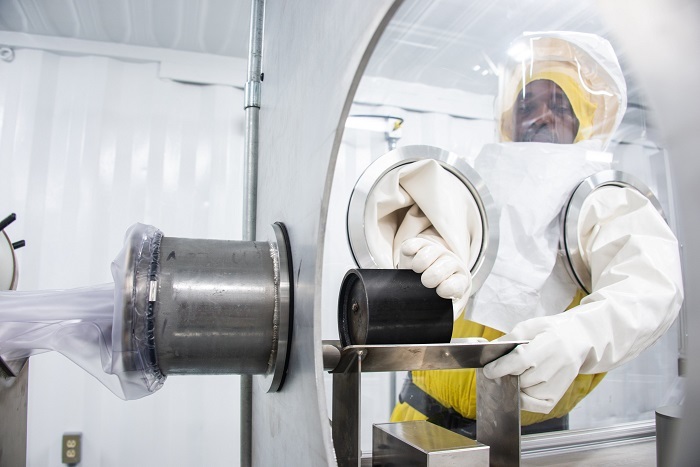 Operator Charlie Stokes uses a specialized cart to move material through a glovebox mock-up as part of training activities for resuming work in the K Area Interim Surveillance glovebox at the Savannah River Site following completion of a process optimization outage.
AIKEN, S.C. – The management and operations contractor at the Savannah River Site (SRS) recently completed a three-phase process optimization outage to create efficiencies to help DOE expedite plutonium downblending and removal from South Carolina.
The efficiencies introduced in the outage at the K Area Interim Surveillance (KIS) glovebox completed by Savannah River Nuclear Solutions (SRNS) are projected to result in significant cost avoidances over the next five years.
“These important improvements will further our nation’s nonproliferation objectives and work toward strengthening NNSA’s relationship with the great state of South Carolina,” said Nicole Nelson-Jean, EM associate principal deputy assistant secretary for field operations, who previously served as manager of the National Nuclear Security Administration's (NNSA) Savannah River Field Office.
“Combining current and future planned missions at SRS will result in the need for faster plutonium processing,” SRNS K Area Facility Manager Steve Wilkerson said. “All plutonium downblending is done in the KIS glovebox, so we looked for ways to make the process easier and faster while still maintaining safety.”
The KIS glovebox is a stainless-steel enclosure that is 15 feet long and three feet wide with safety glass panels. It has fitted glove-port openings to allow radioactive materials handling, and isolates workers from associated hazards. The glovebox was put into operation in 2007, so it needed to be retrofitted to align with the ramping up of the downblending mission.
The project scope required open glovebox maintenance, which involved removing one of the safety glass panels and attaching a new wing cabinet. This specialized cabinet installed on the side of the glovebox allows for safer and more efficient introduction of nuclear material and processing supplies.
This work is high hazard and required a custom containment structure to be built around the open glovebox area. Operators were required to wear air-fed plastic suits, and temporary glovebox ventilation was installed for contamination control.
A wing cabinet installation was part of the second phase of the K Area Interim Surveillance glovebox process optimization scope.
The three phases of the outage included:
- All work required for construction, such as electrical, that does not require specialized equipment or present high radiological concerns.
- Glovebox panel removal and installation of the wing cabinet. Old equipment and waste were removed from the open glovebox panel and new equipment was put inside.
- Tie-in of the rest of the equipment from Phase 1 that could not be completely installed until Phase 2 was completed. At the start of Phase 3, the containment structure was removed, and radiological conditions were returned to a steady state.
Some of the improvements implemented in the project included installing new material entry and removal devices for the glovebox; acquiring new tools that allow for tight bag closure, minimizing waste generation; designing and fabricating special carts to move the downblending containers through the glovebox; and relocating equipment inside the glovebox to improve efficiency of the downblending process flow.
Staff for downblending moved to two-shift operations before the outage, with the plan of moving to four-shift operations during the next fiscal year to increase processing rates for expedited removal of plutonium from the state. Downblending operations in the optimized glovebox resumed in July 2020.
“I am proud of the team and their commitment to safety during this project,” Wilkerson said. “There was a lot of prep work done before we began the optimization outage. To meet an aggressive schedule for process optimization, our team built and practiced on a mock-up glovebox before beginning any higher risk radiological scope. We did a lot of advanced planning and communicating with the customer to complete this high hazard work in a small space safely. This is the first time open glovebox maintenance has been performed on the KIS glovebox since it was installed in 2007.”
Plutonium downblending is the process of mixing plutonium oxide with a multicomponent adulterant to enable DOE to meet requirements for shipping plutonium to an out-of-state repository for disposition.
“NNSA thanks the SRNS project team and the facility support personnel for their hard work in helping us achieve this important nonproliferation mission,” said Virginia Kay, director of the NNSA Office of Material Disposition. “SRS remains committed to removing plutonium from the state of South Carolina as safely and quickly as possible.”
-Contributor: Lindsey MonBarren
 RICHLAND, Wash. – Crews at Hanford’s tank farms recently completed removal and staging of 52 large concrete covers used to shield hoses for transferring radioactive waste between waste tanks in Hanford’s AY and AP farms. Tank farms are groups of tanks. The covers are known as “barns.” They are being staged as part of a worker safety and infrastructure improvement project until they are used in construction of a hose system that will transfer waste from A Farm to AP Farm. As part of the Direct-Feed Low-Activity Waste approach, which is an EM 2020 priority, the AP Farm will feed pretreated waste to Hanford’s Waste Treatment and Immobilization Plant for vitrification.
-Contributor: Mark McKenna
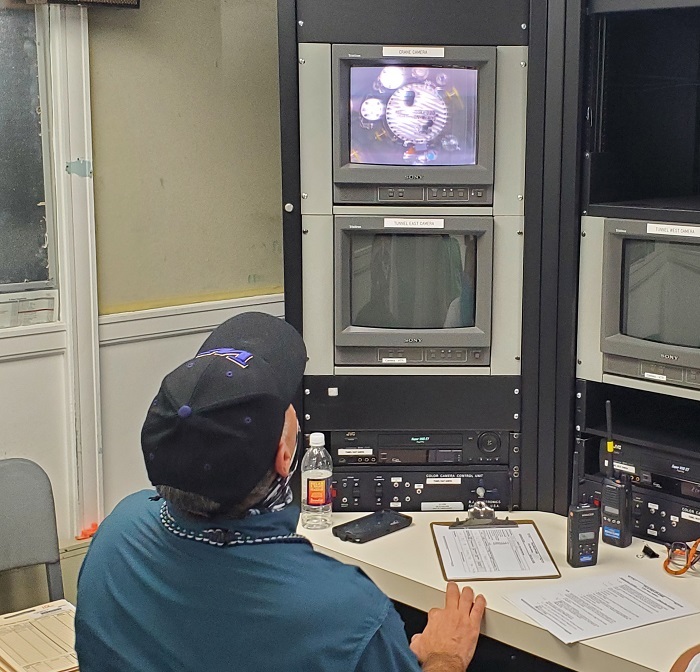
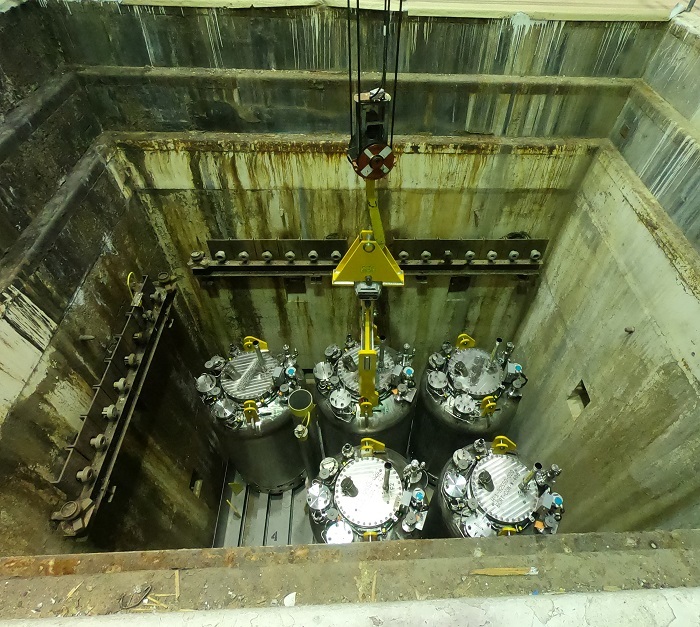 RICHLAND, Wash. – It’s weigh-in time for engineered containers of radioactive sludge from the Hanford Site’s K West Reactor. The containers are in safe interim storage at the site’s T Plant, a former chemical reprocessing facility. Workers with Hanford contractor CH2M HILL Plateau Remediation Company check the 20 containers each year to ensure protective water layers for the sludge are safety maintained at appropriate levels. Workers have checked 14 containers so far in this first annual weigh-in and will finish the other six by the end of the year. The transfer of 35 cubic yards of highly radioactive sludge from the reactor’s fuel storage basin next to the Columbia River to T Plant on the site’s Central Plateau was finished in September 2019. That work reduced a critical risk to the Columbia, the largest North American river flowing into the Pacific Ocean. At top, T Plant Operations Manager Francis Buck performs weigh-ins via a video monitor and remote crane. Pictured immediately above are the containers of sludge at T Plant.
-Contributor: Joan Lucas
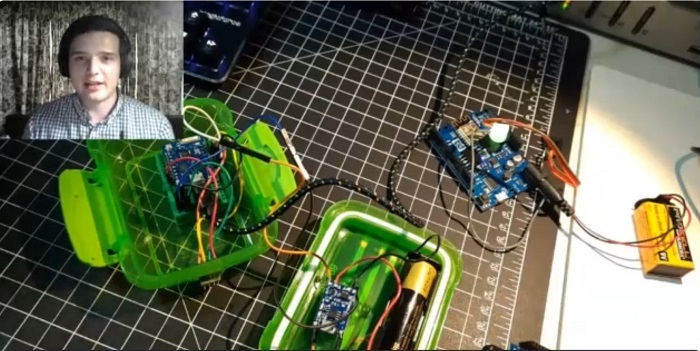 This screen-capture shows a student discussing a weather station lesson at the Virtual STEM Camp in August (photo courtesy of Ohio University).
ATHENS, Ohio – A virtual science, technology, engineering, and math (STEM) camp supported by a grant from EM was conducted recently by Ohio University to educate youth in the region that includes the Portsmouth Site.
From watersheds to renewable energy to smart technologies, students participated in four days of free online sessions funded by the university’s Voinovich School of Leadership and Public Affairs, an EM Portsmouth/Paducah Project Office (PPPO) PORTSfuture grant, and the American Electric Power Foundation.
During the camp, university instructors hosted live presentations and discussions to recreate in-person camp in an online setting. Ohio University has sponsored in-person STEM camps for grades 6-10 over the last two years.
This year’s camp included topics such as water, watersheds, water quality, sampling, and stream biology and health; energy, renewable energy, solar ovens, and energy audits; and smart technologies and coding basics.
The “campers” were mailed boxes of materials to enable hands-on learning. The boxes included a watershed map, pH testing strips, supplies for a make-at-home solar oven, guidebooks, games, and other items.
“The virtual STEM camp provided an engaging and safe opportunity for camp participants to explore environmental science, technology, and energy use at home,” said Jen Bowman, director of environmental programs at the Voinovich School. “Campers were also provided stream sampling tools and encouraged to explore streams in their backyard, neighborhood, or park.”
Information was shared through a data platform called “My Backyard Stream” on watersheddata.com, managed by the university. Participants also conducted a home energy audit, reflected on their personal energy use, and learned how computer programming is used to control drones and other smart devices.
One of PPPO’s many southern Ohio outreach efforts, PORTSfuture-supported STEM programs are intended to prepare youth to understand and appreciate data and science-based information, enhance their critical-thinking and problem-solving skills, and prepare for future educational and career opportunities.
“STEM education provides a strong basis for how we can protect the environment, deal with disease, and improve society,” said PPPO’s Richard Bonczek, who oversees the PORTSfuture grant for EM.
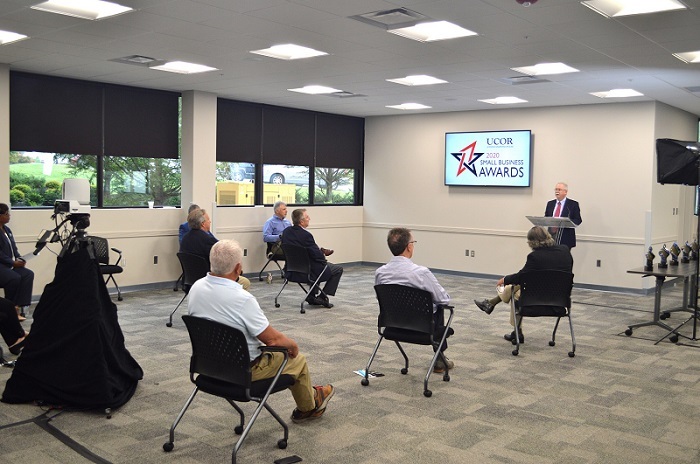 Tim Melberg, UCOR’s manager of supply chain management, speaks at the company’s eighth annual Small Business Awards Program. The event recognized top performers whose exceptional performance contributed to cleanup accomplishments. UCOR is the Oak Ridge Office of Environmental Management's cleanup contractor.
OAK RIDGE, Tenn. – The importance of small businesses in supporting Oak Ridge’s EM mission was on full display last week at the eighth annual Small Business Awards Breakfast.
This year’s event, hosted by Oak Ridge cleanup contractor UCOR, featured a small group of executives and representatives from the winning companies at a socially-distanced gathering, while others watched virtually.
The event recognized top performers that contributed to cleanup accomplishments. Criteria for the winners included developing creative and unique solutions, exhibiting extraordinary customer service, making gains in productivity and efficiency, and coming up with innovative ideas that lead to cost, time, or resource savings.
“With the scale and complexity of our projects, every partner and every role matters to successfully achieve our goal,” said Jay Mullis, manager of the Oak Ridge Office of EM (OREM). “I’m glad to know we have partners like this that will do everything in their power to provide excellent service and find solutions.”
This was an especially crucial year with EM and UCOR working to achieve the EM 2020 priority known as Vision 2020 — the goal to finish taking down a former enrichment complex by the end of the year. The seven award recipients each played a crucial role by providing services ranging from infrastructure support to welding, metal fabrication, and providing nuclear and industrial safety supplies.
UCOR honored the following Tennessee-based companies with awards:
-
Small Businesses of the Year: Workspace Solutions Inc., Knoxville, and
Tellico Electric Inc., Lenoir City.
-
Small Disadvantaged Business of the Year: Steel Plate Fabricators, Knoxville.
-
HUBZone Small Business of the Year: Street Legal Industries, Inc., Oak Ridge. A HUBZone is a historically under-utilized business zone.
-
Woman-Owned Small Business of the Year: Lynx Supply, Inc., Oak Ridge.
-
Veteran-Owned Small Business of the Year: Southeast Equipment Sales, Oak Ridge.
-
Service-Disabled, Veteran-Owned Small Business of the Year: Premier Contracting & Technical Services Inc., Oak Ridge.
UCOR President and CEO Ken Rueter noted that since the inception of UCOR’s contract with OREM in 2011, the company has awarded more than 82 percent of its subcontracting dollars to small businesses, which equates to nearly $1.5 billion.
“We value our subcontractors and depend on them to help us achieve our commitments to DOE. Each of these awardees has proven their commitment to our mission time and again through exceptional support. By partnering with small businesses, we are able to be a more diverse and innovative team. Their willingness to go above and beyond has allowed us to move the cleanup schedule ahead by four years,” Rueter said.
-Contributor: Susanne Dupes
|